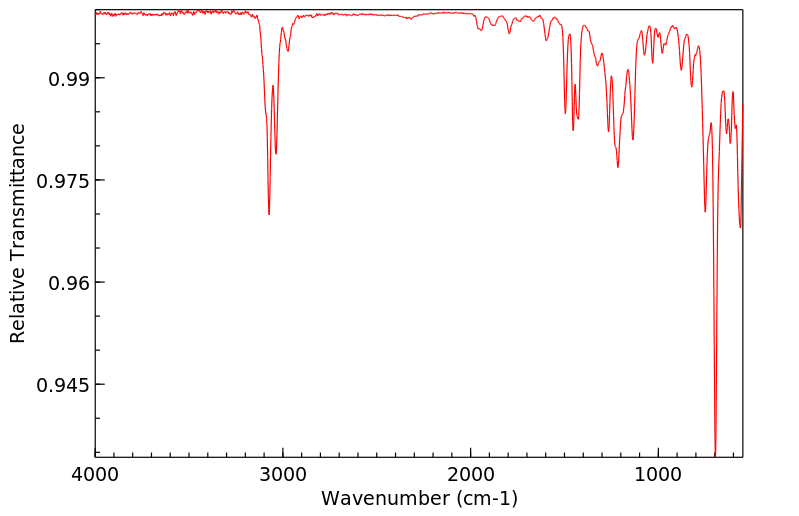(1,2,3-三溴丙基)-苯 | 56762-23-3
中文名称
(1,2,3-三溴丙基)-苯
中文别名
——
英文名称
1,2,3-Tribrom-1-phenylpropan
英文别名
(1,2,3-tribromo-propyl)-benzene;(1,2,3-Tribrom-propyl)-benzol;(1,2,3-Tribromopropyl)benzene;1,2,3-tribromopropylbenzene
CAS
56762-23-3
化学式
C9H9Br3
mdl
——
分子量
356.882
InChiKey
WTSKOLDTABPEPX-UHFFFAOYSA-N
BEILSTEIN
——
EINECS
——
-
物化性质
-
计算性质
-
ADMET
-
安全信息
-
SDS
-
制备方法与用途
-
上下游信息
-
文献信息
-
表征谱图
-
同类化合物
-
相关功能分类
-
相关结构分类
计算性质
-
辛醇/水分配系数(LogP):4.1
-
重原子数:12
-
可旋转键数:3
-
环数:1.0
-
sp3杂化的碳原子比例:0.33
-
拓扑面积:0
-
氢给体数:0
-
氢受体数:0
SDS
上下游信息
反应信息
-
作为反应物:描述:参考文献:名称:Moureu; Gallagher, Bulletin de la Societe Chimique de France, 1921, vol. <4> 29, p. 1010摘要:DOI:
-
作为产物:描述:参考文献:名称:Shabarov,Yu.S.; Saginova,L.G., Journal of Organic Chemistry USSR (English Translation), 1975, vol. 11, p. 1389 - 1393摘要:DOI:
文献信息
-
Brominations with Pr4NBr9 as a Solid Reagent with High Reactivity and Selectivity作者:Jan Streuff、Sebastian Riedel、Thorsten Beck、Heike HallerDOI:10.1055/s-0033-1340705日期:——room-temperature solid reagent for rapid bromination reactions of various substrates. The reagent exhibits reactivity similar to that of elemental bromine, but shows higher selectivity and it is easier and safer to store and to handle. Tetrapropylammonium nonabromide (Pr4NBr9) is introduced as a room-temperature solid reagent for rapid bromination reactions of various substrates. The reagent exhibits reactivity
-
Role of Inducible Nitric Oxide Synthase in Skeletal Adaptation to Acute Increases in Mechanical Loading作者:Makoto Watanuki、Akinori Sakai、Takeshi Sakata、Hiroshi Tsurukami、Masao Miwa、Yasuo Uchida、Ken Watanabe、Kyoji Ikeda、Toshitaka NakamuraDOI:10.1359/jbmr.2002.17.6.1015日期:——To clarify the role of nitric oxide (NO) in regulation of bone metabolism in response to skeletal loading, we examined inducible NO synthase (iNOS) gene knockout mice in the tail‐suspension model. Histomorphometric analyses of proximal tibias revealed that 7 days of tail suspension decreased the bone volume (BV/TV) and bone formation rate (BFR/BS) and increased the osteoclast surface (Oc.S/BS) in mice with all iNOS genotypes. Both iNOS+/+ and iNOS+/− mice responded to subsequent 14‐day reloading, with increases in BV/TV and BFR/BS and a decrease in Oc.S/BS, whereas these responses were abolished in iNOS−/− mice. The osteoblasts flattened after tail suspension appeared cuboidal during subsequent reloading. Immunoreactivity for iNOS was detected in these osteoblasts and osteocytes by immunohistochemistry. These defective responses after reloading were rescued in iNOS−/− mice by treatment with an NO donor nitroglycerine (NG). Conversely, the responses in iNOS+/+ mice were inhibited by treatment with an NOS inhibitor aminoguanidine (AG). In bone marrow cell cultures, mineralized nodules derived from iNOS−/− mice after reloading were significantly reduced. Taken together, our results suggest that NO generated by iNOS in osteoblasts plays a critical role in adjusting bone turnover and increasing osteogenic activity in response to the acute increase in mechanical loading after tail suspension.为了明确一氧化氮(NO)在骨骼负荷下调节骨代谢中的作用,我们在尾悬吊模型中研究了诱导型一氧化氮合酶(iNOS)基因敲除小鼠。胫骨近端组织形态学分析表明,在所有 iNOS 基因型小鼠中,尾悬吊 7 天会降低骨量(BV/TV)和骨形成率(BFR/BS),增加破骨细胞表面(Oc.S/BS)。iNOS+/+ 和 iNOS+/- 小鼠对随后 14 天的再加载均有反应,BV/TV 和 BFR/BS 增加,Oc.S/BS 减少,而 iNOS-/- 小鼠的这些反应消失。尾部悬浮后扁平的成骨细胞在随后的重装过程中出现了立方体。通过免疫组化在这些成骨细胞和骨细胞中检测到了 iNOS 的免疫反应。用氮氧化物供体硝酸甘油(NG)处理 iNOS-/- 小鼠后,重装后的这些缺陷反应得到了挽救。相反,用 NOS 抑制剂氨基胍(AG)处理 iNOS+/+ 小鼠,则可抑制其反应。在骨髓细胞培养中,iNOS-/-小鼠重负荷后产生的矿化结节明显减少。综上所述,我们的研究结果表明,iNOS 在成骨细胞中产生的 NO 对调整骨转换和增加成骨活性起着关键作用,以应对尾悬吊后机械负荷的急性增加。
-
Klages; Klenk, Chemische Berichte, 1906, vol. 39, p. 2553作者:Klages、KlenkDOI:——日期:——
-
Prevost, Bulletin de la Societe Chimique de France, 1931, vol. <4> 49, p. 1372,1376作者:PrevostDOI:——日期:——
-
Hydrogen Fluoride as a Condensing Agent. VI.<sup>1</sup> The Alkylation of Benzene with Compounds Containing an “Allylic” Group作者:J. H. Simons、S. ArcherDOI:10.1021/ja01875a054日期:1939.6
表征谱图
-
氢谱1HNMR
-
质谱MS
-
碳谱13CNMR
-
红外IR
-
拉曼Raman
-
峰位数据
-
峰位匹配
-
表征信息
同类化合物
(βS)-β-氨基-4-(4-羟基苯氧基)-3,5-二碘苯甲丙醇
(S,S)-邻甲苯基-DIPAMP
(S)-(-)-7'-〔4(S)-(苄基)恶唑-2-基]-7-二(3,5-二-叔丁基苯基)膦基-2,2',3,3'-四氢-1,1-螺二氢茚
(S)-盐酸沙丁胺醇
(S)-3-(叔丁基)-4-(2,6-二甲氧基苯基)-2,3-二氢苯并[d][1,3]氧磷杂环戊二烯
(S)-2,2'-双[双(3,5-三氟甲基苯基)膦基]-4,4',6,6'-四甲氧基联苯
(S)-1-[3,5-双(三氟甲基)苯基]-3-[1-(二甲基氨基)-3-甲基丁烷-2-基]硫脲
(R)富马酸托特罗定
(R)-(-)-盐酸尼古地平
(R)-(-)-4,12-双(二苯基膦基)[2.2]对环芳烷(1,5环辛二烯)铑(I)四氟硼酸盐
(R)-(+)-7-双(3,5-二叔丁基苯基)膦基7''-[((6-甲基吡啶-2-基甲基)氨基]-2,2'',3,3''-四氢-1,1''-螺双茚满
(R)-(+)-7-双(3,5-二叔丁基苯基)膦基7''-[(4-叔丁基吡啶-2-基甲基)氨基]-2,2'',3,3''-四氢-1,1''-螺双茚满
(R)-(+)-7-双(3,5-二叔丁基苯基)膦基7''-[(3-甲基吡啶-2-基甲基)氨基]-2,2'',3,3''-四氢-1,1''-螺双茚满
(R)-(+)-4,7-双(3,5-二-叔丁基苯基)膦基-7“-[(吡啶-2-基甲基)氨基]-2,2”,3,3'-四氢1,1'-螺二茚满
(R)-3-(叔丁基)-4-(2,6-二苯氧基苯基)-2,3-二氢苯并[d][1,3]氧杂磷杂环戊烯
(R)-2-[((二苯基膦基)甲基]吡咯烷
(R)-1-[3,5-双(三氟甲基)苯基]-3-[1-(二甲基氨基)-3-甲基丁烷-2-基]硫脲
(N-(4-甲氧基苯基)-N-甲基-3-(1-哌啶基)丙-2-烯酰胺)
(5-溴-2-羟基苯基)-4-氯苯甲酮
(5-溴-2-氯苯基)(4-羟基苯基)甲酮
(5-氧代-3-苯基-2,5-二氢-1,2,3,4-oxatriazol-3-鎓)
(4S,5R)-4-甲基-5-苯基-1,2,3-氧代噻唑烷-2,2-二氧化物-3-羧酸叔丁酯
(4S,4''S)-2,2''-亚环戊基双[4,5-二氢-4-(苯甲基)恶唑]
(4-溴苯基)-[2-氟-4-[6-[甲基(丙-2-烯基)氨基]己氧基]苯基]甲酮
(4-丁氧基苯甲基)三苯基溴化磷
(3aR,8aR)-(-)-4,4,8,8-四(3,5-二甲基苯基)四氢-2,2-二甲基-6-苯基-1,3-二氧戊环[4,5-e]二恶唑磷
(3aR,6aS)-5-氧代六氢环戊基[c]吡咯-2(1H)-羧酸酯
(2Z)-3-[[(4-氯苯基)氨基]-2-氰基丙烯酸乙酯
(2S,3S,5S)-5-(叔丁氧基甲酰氨基)-2-(N-5-噻唑基-甲氧羰基)氨基-1,6-二苯基-3-羟基己烷
(2S,2''S,3S,3''S)-3,3''-二叔丁基-4,4''-双(2,6-二甲氧基苯基)-2,2'',3,3''-四氢-2,2''-联苯并[d][1,3]氧杂磷杂戊环
(2S)-(-)-2-{[[[[3,5-双(氟代甲基)苯基]氨基]硫代甲基]氨基}-N-(二苯基甲基)-N,3,3-三甲基丁酰胺
(2S)-2-[[[[[((1S,2S)-2-氨基环己基]氨基]硫代甲基]氨基]-N-(二苯甲基)-N,3,3-三甲基丁酰胺
(2S)-2-[[[[[[((1R,2R)-2-氨基环己基]氨基]硫代甲基]氨基]-N-(二苯甲基)-N,3,3-三甲基丁酰胺
(2-硝基苯基)磷酸三酰胺
(2,6-二氯苯基)乙酰氯
(2,3-二甲氧基-5-甲基苯基)硼酸
(1S,2S,3S,5S)-5-叠氮基-3-(苯基甲氧基)-2-[(苯基甲氧基)甲基]环戊醇
(1S,2S,3R,5R)-2-(苄氧基)甲基-6-氧杂双环[3.1.0]己-3-醇
(1-(4-氟苯基)环丙基)甲胺盐酸盐
(1-(3-溴苯基)环丁基)甲胺盐酸盐
(1-(2-氯苯基)环丁基)甲胺盐酸盐
(1-(2-氟苯基)环丙基)甲胺盐酸盐
(1-(2,6-二氟苯基)环丙基)甲胺盐酸盐
(-)-去甲基西布曲明
龙蒿油
龙胆酸钠
龙胆酸叔丁酯
龙胆酸
龙胆紫-d6
龙胆紫







